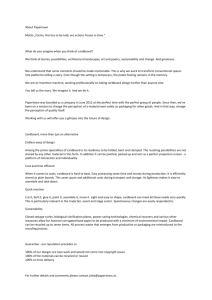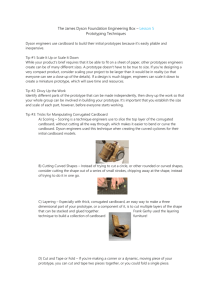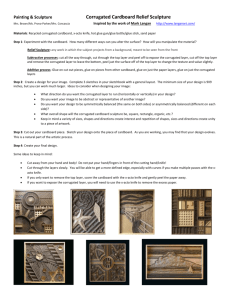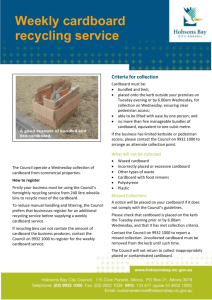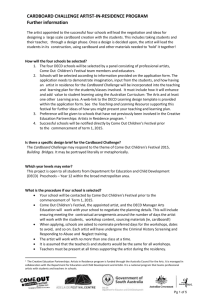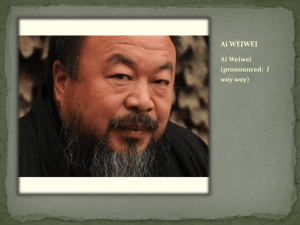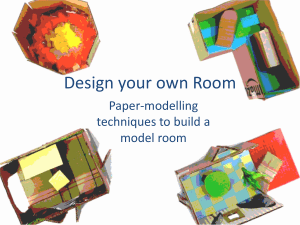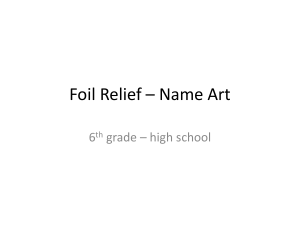Cardboard sculpture
advertisement
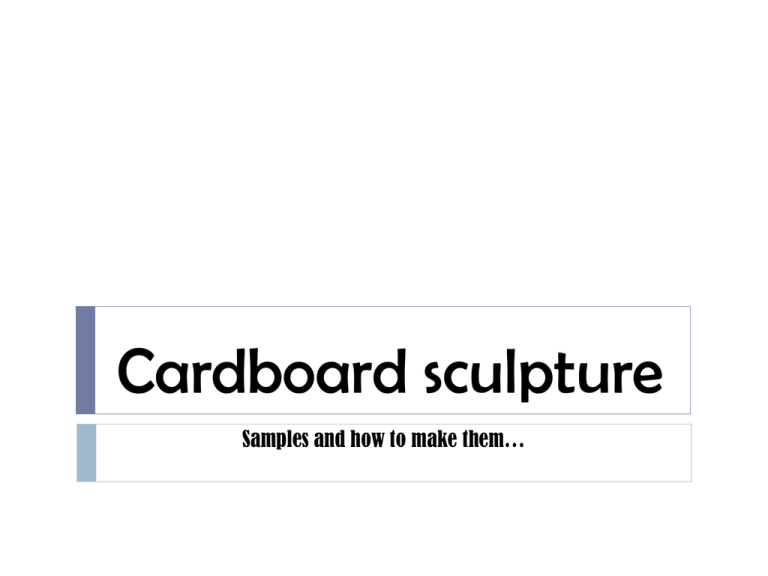
Cardboard sculpture Samples and how to make them… Italian artist Peeta is renowned for his graffiti, but it’s his 3-D interpretations of his art that make him really stand out from the crowd. Cardboard is among the materials Peeta has used to transform written graffiti into complex forms that have been featured in galleries around the world. Cut out layers Montreal-based artist Laurence Vallières creates animal sculptures using layered cardboard cutouts taken from found boxes. Cardboard artist, Scott Fife: Scott Fife has been exhibiting his sculptures and drawings since 1976 in galleries in Chicago, Seattle, Los Angeles and Vancouver, BC and in museums including the Frye Museum (Seattle), the Tacoma Art Museum, the Boise Art Museum, the Northwest Museum of Arts and Culture (Spokane). His work was included in the 2008 Art on Paper Biennial at the Weatherspoon Museum of Art in Greensboro, NC. "I like the physical nature of building the sculpture–it seems very oldfashioned and traditional. The idea of the material itself–it’s friendly, flexible, there’s a glow from in it. I’m the full-service artist–doing it all at the moment. I like the aspect of the low-tech tools that I need to make something like this. In the beginning [it was] an X-acto knife, masking tape and glue–now it’s the screw gun. So that hasn’t changed much at all–the directness of it, that I could begin to shape this, I can make this very plastic without any special process. http://en.paperblog.com/incredible-cardboard-sculptures-by-scott-fife59882/ A little bit about the artist: Jacqui Oakly from Ontario Canada Process: Boar & Fox Masks January 15th, 2013 Even though I paint for a living, I still enjoy doing larger scale or more experimental work for art shows. It’s a good excuse to rediscover one’s enjoyment of making art, which sometimes can be forgotten when it becomes part of a daily routine (I know, shame on me). After exhibits I always learn something that I bring back to my illustration work, whether it’s a slightly new technique or subject matter or it’s purely a re-energizment. This winter I was lucky to be in two art shows where I took the opportunity to try something a little different from my usual work and create some 3D pieces. I wanted to create pieces that forced me to not rely on my usual skills and would stretch my typical boundaries. I also wanted to do art that was a little more physical and get away from my studio table, so why not cardboard masks, I thought? Below you’ll find some of my process for these cardboard critters which will be hanging up guarding my other paintings until the end of February at De Facto at Mulberry (193 James St. North, Hamilton, Ontario). Such a lovely gallery–thanks so much to Oliver and Ella for inviting me to show my work there. Here’s my third mask of the series, “The Boar” and the fourth mask ‘The Fox”. http://jacquioakley.com/boar-fox-masks Notching instead of layering like the past slides: Notching and layering can be combined to get another effect. Corrugated Fountain: Cardboard Sculpture by James Grashow - See more at: http://www.faithistorment.com/2012/04/corrugated-fountaincardboard-sculpture.html#sthash.rTCe22qd.dpuf What you can make out of toilet paper tubes, (this would be for extra credit if you work fast): Junior Fritz Jacquet is an artist that loves working with paper and has created a series of small masks by bending and folding empty toilet paper rolls. Good looking, Junior (we named the dog Indiana). I really think this is testament to the creativity of the human mind. It's amazing, you know? Junior here sees an empty toilet paper roll and thinks art. Me? I think, "damnit -- what hand's it gonna be this time?" Cardboard Sculpture project: 1. You will create a cardboard sculpture of your own. Preferably one that can ahng on the wall due to lack of storage space. We will have to hang theses as you work from the clothes line or on the walls or in the drying rack. 2. Materials provided will be what cardboard we have in the classroom, scissors and white glue. You also may use tempra paint when it is finished if you have enough time. We do not have a glue gun to use so you must plan as you work on how you will store your work in progress such as hanging or the drying rack. Both notching and layering are the techniques I would like to see applied. Doing both will give you a higher grade for effort. 3. You are encouraged to bring cardboard from home. Think about the cereal boxes=s you throw out and any other type of box you toss out in the trash. Cardboard sculpture is recycling at its best. 4. You must consider balance and negative and positive space. Will it be concave, convex, or both. 5. You will be graded on neatness, technique and originality. Do NOT copy another artist you find on the internet and think I have not seen it. That will result in a “0” grade regardless of the effort you put in. This means no “Hello Kitty” sculpture or “Hatchet Man” or any other iconic image that is copyrighted by another! 6. If you finish before others you are not permitted to sit around and do nothing. That will hurt your grade and be taken out of participation and even your project if you are excessive at wasting class time. You are to use this time creating or trying to create smaller art like the toilet paper tube faces in the previous slides 7. I am expecting this project to take about 3 weeks before we move on to more recycled art sculpture. Some web sties we will explore if there is time and I suggest you explore these even more on your own http://www.squidoo.com/cardboard-sculpture http://www.inspirationgreen.com/cardboard-sculpture-and-accessories.html http://www.youtube.com/watch?v=71fpmaRvZ8g http://www.youtube.com/watch?v=QpsaapegRuQ http://www.ikatbag.com/2011/03/how-to-work-with-cardboard.html
